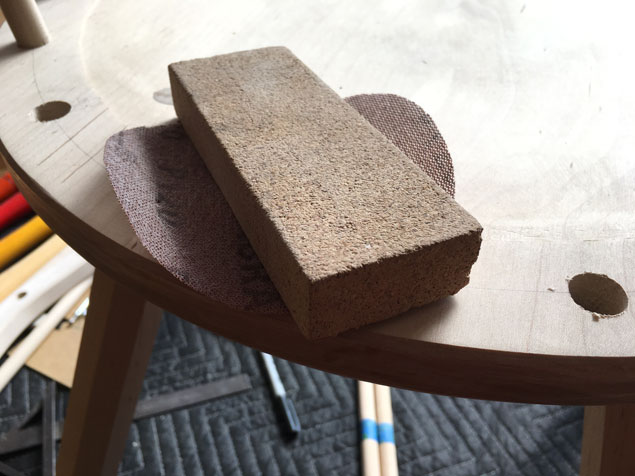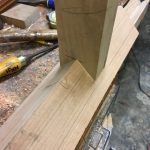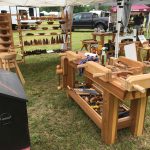We may receive a commission when you use our affiliate links. However, this does not impact our recommendations.
When I wrote about the 50 or so essential hand tools you need to make furniture in “The Anarchist’s Tool Chest,” I neglected to include my cork sanding block in that list. I think the reason I forgot was that the block is as essential as my marking knife.
I know the tendency today is to eschew abrasives and finish projects straight from the tools, but that’s a pretty new idea. The Ancient Egyptians finish-sanded their furniture with blocks of sandstone. And virtually every Western culture has employed abrasives as a way to make the wood’s surface level and smooth.
I suspect the reason many hand-tool woodworkers avoid sanding is that in the 20th century the craft had devolved into a drunken madness of power sanding. All surface prep was done with abrasives hooked to machines that dulled both your senses and the work below. It’s unpleasant, dusty and expensive.
If you pay close attention to historical references on abrasives, you find that early woodworkers used them sparingly because they were (and still are) fairly expensive compared to edge tools. So the woodworker would use edge tools to get the surface as perfect as possible. Then abrasives would quickly blend the surfaces together and refine them just a bit more.
And while you can use sandpaper with just your hand, your work will be more crisp by wrapping the abrasive around a cork block. Cork is firm enough to remove chatter from edge tools but soft enough to follow imperceptible high and low spots on the surface.
My personal block of cork is about 1” thick, 2-1/2” wide and 7” long, which is a good size for my hand and to receive the 6”-diameter Abranet discs I use with it.
Sanding should be brief, using a fine grit and refine the surface without changing its shape. Each area of your project should require only five seconds of work. Do this, and you’ll start to consider the cork sanding block an essential hand tool in your chest, too.
— Christopher Schwarz
Here are some supplies and tools we find essential in our everyday work around the shop. We may receive a commission from sales referred by our links; however, we have carefully selected these products for their usefulness and quality.










I like velcro sanding blocks and velcro backed abrasive paper.
I buy a sheet of 1/4″ cork from the hobby store, cut it to size to fit my sanding block, and glue them together. I have over a dozen different sized blocks.
I also make sanding blocks with 1/4″ felt backing . Good for use on hard woods (but not pine).
Yesterday I asked my grand-son: ¿which is the tool I use the most?
He listed all the tools I have but the answer was the same: Hmm.. No!
Finally I show him my humble sanding block.
What a smile of understanding I got.
Helmuth
Chris – Just curious how you cut these blocks. I know they are wood (bark anyway) but I wonder about the binders, etc. Do you use hand tools for this, table saw, what about the finish? I know from the photo yours appear mainly smooth one the key surfaces but the corners are chipped. I am wondering if you sand the cork to flatten after cutting, etc. and if the corner chips are from original shaping, damaging in use, or both.
I like the sheets of self adhesive felt they sell for furniture feet on my sanding block – about 1/8th inch thick
About ten years ago when I first began my woodworking “career,” I took a basic class in which one of the projects was a sanding block to which was glued a sheet of cork. One edge was grooved to accept a wedge to hold the sanding sheet in place. I made it from Cherry and it’s still around somewhere, but I’ve mostly fallen prey to machine sanding. However, my last grit (before finishing) is with an ancient half-sheet finishing sander that is non-orbital. After finishing I only use a cork-faced block for knocking down nibs, etc.
Thanks for the article Chris. That said, it’s not clear whether you describe a VERY brief touching-up with the sand paper here and there or if you are lightly addressing all surfaces of the workpiece. Obviously, spot sanding could be brief, but might leave different a patchy look (or not) and addressing all surfaces is a much lengthier process. Can you please clarify?
http://www.lib.umd.edu/special/guides/the-carpenter-magazine (October 1932 pg’s 25 &26 contributed by a one H. H. Siegele. It is a discussion about cork vs softwood sanding blocks. The block pictured has a unique attachment method for the sandpaper. I made mine in 1966 out of a scrap piece of mahogany with cork sheet glued to the faces with the same attachment method, by the direction of my wood shop teacher. That style of block must have been popular after the 1930’s and then forgotten. I have often been asked about my “odd” sanding block.
In one of the 1800’s mags I think 1888 or 1889, Your full size chest is the subject of an isometric drawing lesson. You can see the construction details are the same, including your tray layout and lid. I completed my chest in 1969 the same way at the stern direction of my Grandfather except it is constructed of a large Chestnut from our farm that was felled by lightning.
The digitized copies of the United Brotherhood of Carpenters magazines have so many interesting tutorials and building methods, and oh, the cool advertisements, once you start looking, it’s hard to quit.
If you can’t find cork blocks, you can buy cork sheeting that is 1/8″ thick at hardware stores and glue it to wood blocks. I recently did the same with Benchcrafted’s “Crubber” (crumb rubber…get it?) vice jaw liner.
I think that the wood base adds a bit more durability to the sanding block.
Would an old bit of 2x scrap with some cork drawer-liner work the same?
So where can you buy 1” thick, 2-1/2” wide and 7” long sanding blocks
all I seem to find are Cork Sanding Blocks that are 110 x 60 x 30mm
or 4-3/4″ x 2-1/4″ x 1-3/8″ in size.
I had never thought about using a cork block before. I am going to get one now. Great post as usual, Thank you!!